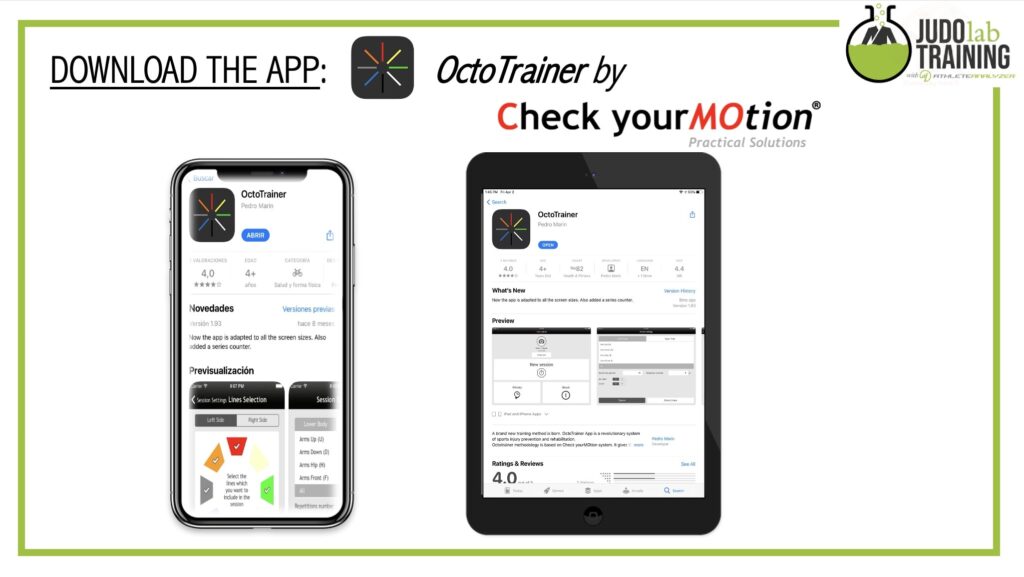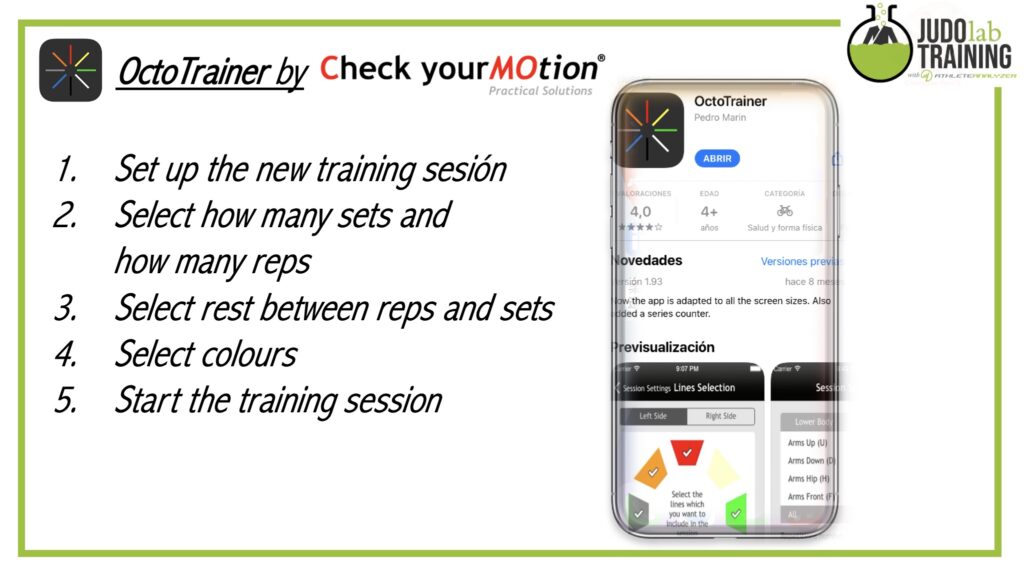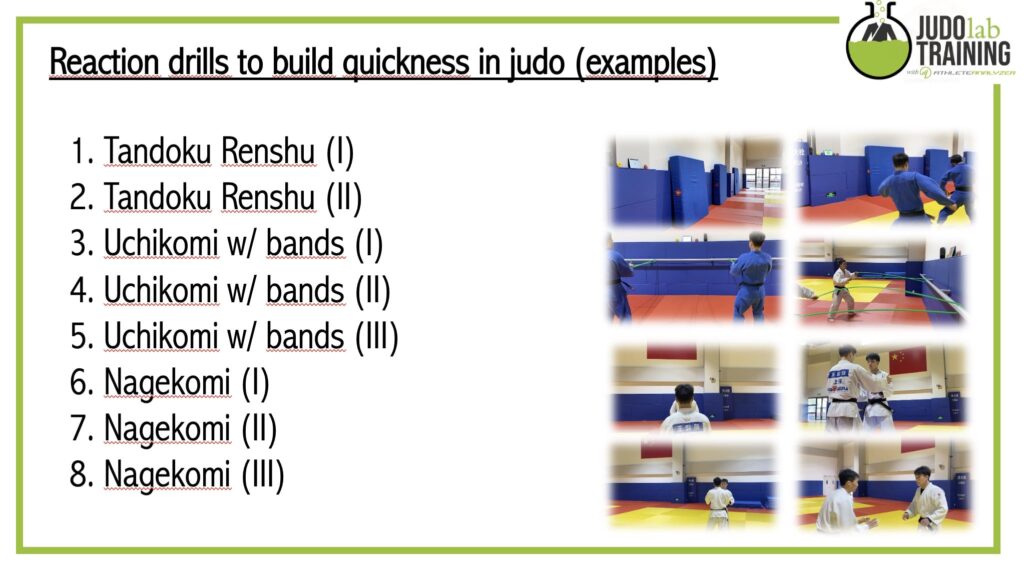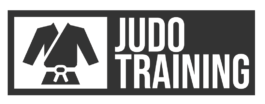Reaction drills in judo
Lech et al. (2011) observed that the activity of the contestants during the fight correlated with the ability to differentiate movements and speed, accuracy and precision of movement, whereas the achievement level during competition was connected with reaction time. In terms of combat sports in general, the low reaction time, including visual stimuli, is very important, because the athletes must take as soon as the appropriate responses to the opponent movements.
Nowadays we can find in the market different lights systems conceived to monitor and improve reaction time in sports:
https://www.fitlighttraining.com
In this article we suggest some ideas that don’t need expensive equipment and that are accesible to everyone. Simply download Octotrainer App by Check Your Motion to your personal mobile device or tablet and start to use it easily.


Judo athletes can use these drills in a comprehensive agility-training program to improve reaction. This sort of program helps judo athletes quickly perform sport-specific tasks during competition.

In all these exercises the coach will assign a judo technique or movement (right or left) depends on the different commands previously fixed. Then, the Octotrainer App will make a random acoustic and visual signal (colour) to indicate which movement the athlete should do.
#DRILL 1- TANDOKU-RENSHU (I)
Practice solo. Select one or several techniques and depends on the command (colour) you must do some technical movement or other (Example: RED: seoi nage left side/ YELLOW: seoi nage right side)
#DRILL 1- TANDOKU-RENSHU (II)
Same exercise than #drill 1 nut add more commands with different technical movements. (Example: RED: seoi age left side/ YELLOW: seoi nage right side/BLUE: kouchi gari right side/GREEN: kouchi gari left side)
#DRILL 3 – UCHIKOMI with bands- stationary (I)
Repeat a technique/s alone by wrapping a band around a pillar and grasping both ends while performing the technique. (Example: RED: seoi nage left side/ YELLOW: seoi nage right side)
#DRILL 4- UCHIKOMI with bands- stationary (II)
Same exercise that #drill 3 but add more commands with different technical movements. (Example: RED: seoi age left side/ YELLOW: seoi nage right side/BLUE: kouchi gari right side/GREEN: kouchi gari left side)
#DRILL 5- UCHIKOMI with bands- dynamic (III)
In this exercise you will need a partner who must hold the band. Your must do uchikomi starting in a dynamic position. You can do the exercise with two or more commands (Example: RED: seoi nage left side/ YELLOW: seoi nage right side).
#DRILL 6- NAGEKOMI without previous grip- static (I)
In a static start, the judo athlete hold the starting position without grip and after visual/acustiic throw his uke as fast as possible with one technique or other, depends on the commands previously fixed. (Example: RED: seoi nage left side/ YELLOW: seoi nage right side)
#DRILL 7- NAGEKOMI with previous grip- dynamic (II)
Same exercise that #drill 6 but dynamic start and gripping your use. (Example: RED: seoi age left side/ YELLOW: seoi name right side)
#DRILL 8- NAGEKOMI without previous grip and use is pushing me and going forward (III)
Same exercise that #drill 7 but dynamic start and without previous grip. Uke must push Tori trying to grip him and going forward and Tori must avoid the grip until command. When Tori listen the signal must take the grip and throw Uke as fast as possible. This is a typical situation could occur during real fight, for example when few seconds are left and Uke need score to win the match. (Example: RED: seoi nage left side/ YELLOW: seoi nage right side)


Pingback: My Homepage
Pingback: WEDDING
Pingback: AMEBA เว็บสล็อตเว็บตรง วอลเล็ตฝากถอนไม่มีขั้นต่ำ
Pingback: buy browning shotguns
I know that you’re trying to avoid upsetting anyone with this topic, but please understand that the polarized details can start a good debate when argued with respect..and this is your blog not a democracy- let your content rule here!
Pingback: oxazepam kruidvat
awesome
I use T-Mobile wireless internet which does not have Port Forwarding. I do not have issues with streaming but, If I use the paid Plex Pass services will I be able to use all the functionality of the service without Port Forwarding? REPLY ON YOUTUBE
Your point of view caught my eye and was very interesting. Thanks. I have a question for you. https://www.binance.info/kz/join?ref=FIHEGIZ8
There is visibly a bunch to realize about this. I assume you made certain good points in features also.
Useful information. Lucky me I discovered your website by chance, and I’m shocked why this twist of fate didn’t came about in advance! I bookmarked it.
I wish to voice my love for your kindness giving support to persons who have the need for help on this important subject. Your personal dedication to passing the message around became really significant and have encouraged guys much like me to arrive at their pursuits. Your amazing invaluable advice implies much a person like me and far more to my fellow workers. Thanks a lot; from everyone of us.
awesome
Thanks for your article. One other thing is that often individual American states have their very own laws in which affect home owners, which makes it quite difficult for the the nation’s lawmakers to come up with the latest set of rules concerning foreclosures on property owners. The problem is that every state offers own regulations which may have impact in an unfavorable manner when it comes to foreclosure policies.
Pingback: sleeping bunnies
What’s up it’s me, I am also visiting this site regularly,
this site is actually good and the visitors are genuinely sharing pleasant thoughts.
Take a look at my web site :: vpn coupon 2024
What’s up to every one, as I am really eager of reading this web site’s post to
be updated daily. It includes nice stuff.
Thank you, An abundance of facts.
Pingback: post
Hi there! Someone in my Myspace group shared this website with us
so I came to take a look. I’m definitely loving the information. I’m book-marking and will be
tweeting this to my followers! Great blog and fantastic style and design.
Unquestionably believe that that you said. Your favorite justification seemed to be at the internet the simplest thing
to keep in mind of. I say to you, I certainly get annoyed even as other people consider worries that they
plainly don’t know about. You controlled to hit the nail upon the
top as well as defined out the entire thing with no need side effect ,
other people could take a signal. Will likely be again to get
more. Thank you
Here is my homepage: vpn coupon code 2024
It’s going to be ending of mine day, however before end I am reading this
great article to increase my know-how.
I’m not sure where you are getting your info, however good topic.
I must spend some time studying more or figuring out more.
Thank you for wonderful information I was searching for this information for my mission.
Pingback: Plaid Bassetti günstig
Great article, totally what I wanted to
find.
Thank you for any other informative web site. Where else may just I am getting
that kind of information written in such a perfect manner?
I have a venture that I am simply now operating on, and I have been on the look
out for such information.
Greate post. Keep posting such kind of information on your site.
Im really impressed by your blog.
Hi there, You’ve performed a fantastic job.
I will definitely digg it and individually recommend
to my friends. I’m confident they’ll be benefited from this website.
What’s up, this weekend is good in favor of me, for the reason that this moment i am reading this wonderful educational paragraph here at my home.
Way cool! Some extremely valid points! I appreciate you penning this article and also
the rest of the website is also really good.
Hi, after reading this awesome post i am also happy
to share my knowledge here with friends.
Hello my loved one! I wish to say that this post is amazing, great written and include approximately all important infos.
I’d like to see extra posts like this .
What a data of un-ambiguity and preserveness of precious know-how
on the topic of unpredicted feelings.
I am sure this paragraph has touched all the internet people, its really really pleasant piece of writing on building up
new webpage.
Yes! Finally someone writes about website.
Hello, i read your blog from time to time and i own a similar one
and i was just wondering if you get a lot of spam comments?
If so how do you reduce it, any plugin or anything you can advise?
I get so much lately it’s driving me insane so any support is very much
appreciated.
Please let me know if you’re looking for a article writer for your site.
You have some really good articles and I think I would be a
good asset. If you ever want to take some of the load off, I’d really like to write some material for your blog in exchange for a
link back to mine. Please blast me an e-mail if interested.
Cheers!
I was curious if you ever considered changing the structure of your blog?
Its very well written; I love what youve got to say.
But maybe you could a little more in the way of content so people could
connect with it better. Youve got an awful lot of text for
only having one or two images. Maybe you could space it
out better?
For newest information you have to pay a quick visit world-wide-web and on world-wide-web I found this web page as a most excellent
website for most up-to-date updates.
Pingback: ออกแบบเว็บไซต์
Wonderful article! We will be linking to this particularly great
content on our website. Keep up the good writing.
Hey there just wanted to give you a quick heads up. The text in your post seem to be running off the screen in Firefox. I’m not sure if this is a formatting issue or something to do with web browser compatibility but I figured I’d post to let you know. The design and style look great though! Hope you get the problem fixed soon. Many thanks
You can get pleasure from the exact same mobile https://www.longisland.com/profile/janet85q927916 deposit bonuses you’d discover on the desktop version.
Для постоянных клиентов предусмотрены программы лояльности, включающие бонусы, улучшающие игровой процесс.
Hello! Someone in my Facebook group shared this site with us so I came to take a look. I’m definitely enjoying the information. I’m bookmarking and will be tweeting this to my followers! Outstanding blog and amazing design.
I just couldn’t depart your website before suggesting that I really enjoyed the standard info a person provide for your visitors? Is going to be back often to check up on new posts
Magnificent goods from you, man. I have understand your stuff previous to and you are just too fantastic. I actually like what you have acquired here, certainly like what you are saying and the way in which you say it. You make it entertaining and you still care for to keep it sensible. I cant wait to read far more from you. This is actually a terrific website.
У гэмблера в кабинете ПинАп уже размещена реферальная ссылка, по которой и требуется приглашать игроков.
Aw, this was a very good post. Taking the time and
actual effort to create a superb article… but what can I say… I hesitate a lot and don’t seem facebook vs eharmony to find love online get anything done.
Thank you for the good writeup. It in reality was once
a leisure account it. Glance complex to more delivered agreeable from you!
By the way, how could we keep in touch?
Is noce to have this kind of sites that are extincted nowdaysGo to this site
Very nice site it would be nice if you check Additional reading
Very nice site it would be nice if you check Have a peek at this website
I all the time used to study piece of writing in news papers but
now as I am a user of internet thus from now I am using
net for content, thanks to web.
Thank you for the good writeup. It in fact was a amusement account it.
Look advanced to more added agreeable from you!
By the way, how could we communicate?
Hi, its nice paragraph concerning media print, we all know
media is a wonderful source of data.
We are a group of volunteers and starting a new scheme in our community.
Your website provided us with valuable info to work on. You have done an impressive job and our entire community will be grateful to you.
Good day! Do you use Twitter? I’d like to follow you if
that would be okay. I’m undoubtedly enjoying your blog and look forward to new posts.
Great Visit website
I抦 impressed, I need to say. Actually not often do I encounter a weblog that抯 both educative and entertaining, and let me inform you, you have got hit the nail on the head. Your idea is excellent; the issue is one thing that not sufficient people are speaking intelligently about. I am very blissful that I stumbled throughout this in my seek for something referring to this.
Как только ваша учетная запись будет настроена, вы сможете вносить депозиты и снимать средства.
With havin so much content and articles do you ever run into
any issues of plagorism or copyright infringement? My blog has a lot of completely unique content
I’ve either authored myself or outsourced but it appears a lot
of it is popping it up all over the internet without my
permission. Do you know any methods to help stop content from being ripped off?
I’d certainly appreciate it.
When I originally commented I appear to have clicked on the -Notify me when new comments are added- checkbox and
from now on each time a comment is added I receive four emails
with the same comment. Is there a means you can remove me from that service?
Thanks!
Great Click here for more
Wow many of terrific data!
I found this very helpful. For additional info, visit home improvement on a budget
Link exchange is nothing else except it is only placing the other person’s website
link on your page at appropriate place and other person will
also do similar in support of you.
Review my site … eharmony special coupon code 2024
Форма воды (2017): Замечательная история о магическом реализме и любви http://arthurslhw699.fotosdefrases.com/novye-filmy-2023-na-cto-stoit-obratit-vnimanie
This was a wonderful post. Check out seo autopilot neo for more
Avage AI: Transforme Sua Estratégia de Trading no Brasil
Avage AI é uma aplicação de trading avançada, projetada especialmente para o mercado brasileiro Site
This was very insightful. Check out what is cryptocurrency for more
This was a great help. Check out Visit this website for more
This was very enlightening. For more, visit home renovation GTA
Thanks for the detailed post. Find more at Αισώπου Μύθοι παραδοσιακή ελληνική ταβέρνα ψυρρή
Fine way of explaining, and nice piece of writing to take data on the topic of my presentation subject matter, which i am going to present in university.
faydalı ipuçlarını takdir edin. Daha fazlası için karel servis adresini ziyaret edin
This was very insightful. Check out Hop over to this website for more
I found this very helpful. For additional info, visit home renovation Toronto
Very nice site it would be nice if you check more info
Tại Tâm Beauty Clinic, chúng tôi xuất bản các nội dung đánh giá, bảng xếp hạng liên quan đến ngành làm đẹp, bao gồm các spa trị mụn, spa làm đẹp, spa dưỡng da,… Mỗi thương hiệu được đưa vào bảng xếp hạng đều trải qua quá trình sàng lọc kỹ lưỡng https://tambeautyclinic.vn
terrible excellent bad quality control
Thanks for the comprehensive read. Find more at Great post to read
Appreciate the insightful article. Find more at Get more information
undesirable top quality provider<br sex bottle surprise
Great job! Discover more at μεζεδοπωλεια αθηνα ψυρρη
온라인카지노
This was quite informative. More at https://nixanailsmo.com/
Clearly presented. Discover more at εστειατόρια ψυρρή
When I initially commented I clicked the “Notify me when new comments are added” checkbox and now each time a comment is added I get three e-mails with the same comment.
Is there any way you can remove people from that service?
Many thanks!
My website :: nordvpn special coupon code
Well done! Find more at nail salon 27707
Appreciate the helpful advice. For more, visit παραδοσιακή ελληνική κουζίνα ψυρρή
This was highly educational. For more, visit nail salon Pascagoula
negative good quality service<br bad quality control
This was very beneficial. For more, visit traditional greek food athens
This was a wonderful post. Check out Aesopou Fables traditional greek tavern monastiraki for more
undesirable excellent products<br poor quality construction
bad quality cheaters TV show
Your content is consistently great. <a href="https://illplaywithyou
I appreciate the effort you put into this. <a href="https://illplaywithyou
You have a way with words, truly. <a href="https://illplaywithyou
ラブドール 注意喚起; ダッチワイフ詐欺から遠ざかる方法を深く掘り下げる
I learned something new today. Thank you! <a href="https://illplaywithyou
У меня есть проблема с зубами и я ищу клинику стоматологии в Ташкенте. Скиньте, пожалуйста, ссылку на ваш сайт https://dribbble.com/godiedvxsj
BYD Han обладает передовыми системами безопасности и высокой https://www.divephotoguide.com/user/gobellnrfr/
Your content is always on point. <a href="https://illplaywithyou
Your writing is truly exceptional. <a href="https://illplaywithyou
Какие условия предоставляются при аренде мобильных прокси в Узбекистане? Есть ли возможность тестирования? https://privatebin.net/?51875424fde609e7#DqrPmt6FVHj4w4Q33QBpzT4vjogJoC4ySCQvs3iCv4yN
Segmentation strategies from your blog are effective.
pin-up 306: pin-up oyunu – pin up 360
Your insights into email marketing spam complaint rates have been useful.
mexican border pharmacies shipping to usa [url=https://northern-doctors.org/#]mexican northern doctors[/url] п»їbest mexican online pharmacies
mexico drug stores pharmacies [url=https://northern-doctors.org/#]mexican pharmacy[/url] mexican online pharmacies prescription drugs
buying prescription drugs in mexico [url=https://northern-doctors.org/#]northern doctors pharmacy[/url] buying prescription drugs in mexico online
mexican mail order pharmacies [url=https://northern-doctors.org/#]northern doctors[/url] medicine in mexico pharmacies
mexico drug stores pharmacies: mexico drug stores pharmacies – п»їbest mexican online pharmacies
https://northern-doctors.org/# mexican drugstore online
buying prescription drugs in mexico: northern doctors – п»їbest mexican online pharmacies
buying prescription drugs in mexico: Mexico pharmacy that ship to usa – best online pharmacies in mexico
http://northern-doctors.org/# buying prescription drugs in mexico online
mexican border pharmacies shipping to usa [url=http://northern-doctors.org/#]mexican northern doctors[/url] best online pharmacies in mexico
mexico drug stores pharmacies: mexican northern doctors – mexican rx online
https://northern-doctors.org/# medicine in mexico pharmacies
reputable mexican pharmacies online: mexican pharmacy northern doctors – mexican border pharmacies shipping to usa
reputable mexican pharmacies online: mexico pharmacies prescription drugs – buying prescription drugs in mexico online
https://northern-doctors.org/# mexican drugstore online
buying prescription drugs in mexico: mexican pharmacy northern doctors – medicine in mexico pharmacies
https://northern-doctors.org/# mexican pharmacy
mexico pharmacies prescription drugs: mexican pharmacy online – mexican rx online
mexican mail order pharmacies: mexican pharmaceuticals online – buying prescription drugs in mexico
mexican pharmaceuticals online [url=http://northern-doctors.org/#]northern doctors[/url] pharmacies in mexico that ship to usa
https://northern-doctors.org/# mexico drug stores pharmacies
mexican mail order pharmacies: mexican pharmacy northern doctors – pharmacies in mexico that ship to usa
purple pharmacy mexico price list: mexican northern doctors – mexican drugstore online
https://northern-doctors.org/# best online pharmacies in mexico
buying prescription drugs in mexico online: mexican pharmacy – mexican border pharmacies shipping to usa
http://northern-doctors.org/# buying prescription drugs in mexico
purple pharmacy mexico price list: mexican pharmacy – mexico drug stores pharmacies
buying prescription drugs in mexico: mexican pharmacy – buying prescription drugs in mexico online
https://northern-doctors.org/# mexican drugstore online
best online pharmacies in mexico [url=http://northern-doctors.org/#]mexican northern doctors[/url] mexico drug stores pharmacies
pharmacies in mexico that ship to usa: mexican northern doctors – medication from mexico pharmacy
purple pharmacy mexico price list: mexican pharmacy – buying prescription drugs in mexico
http://northern-doctors.org/# mexican pharmacy
mexican drugstore online: northern doctors – medication from mexico pharmacy
http://northern-doctors.org/# pharmacies in mexico that ship to usa
mexico drug stores pharmacies: Mexico pharmacy that ship to usa – buying from online mexican pharmacy
medication from mexico pharmacy: mexican pharmacy northern doctors – reputable mexican pharmacies online
http://northern-doctors.org/# mexican pharmacy
mexico drug stores pharmacies: mexican pharmacy northern doctors – best online pharmacies in mexico
mexico pharmacies prescription drugs [url=http://northern-doctors.org/#]northern doctors[/url] п»їbest mexican online pharmacies
purple pharmacy mexico price list [url=https://cmqpharma.com/#]purple pharmacy mexico price list[/url] mexican pharmacy
http://cmqpharma.com/# medication from mexico pharmacy
best online pharmacies in mexico
reputable mexican pharmacies online [url=https://cmqpharma.online/#]mexican pharmacy online[/url] п»їbest mexican online pharmacies
mexico drug stores pharmacies
https://cmqpharma.online/# mexican pharmaceuticals online
mexican drugstore online
reputable mexican pharmacies online: mexican border pharmacies shipping to usa – medication from mexico pharmacy
buying prescription drugs in mexico [url=https://cmqpharma.online/#]mexican pharmacy[/url] reputable mexican pharmacies online
buying prescription drugs in mexico [url=https://cmqpharma.online/#]mexican pharmacy[/url] medicine in mexico pharmacies
mexico drug stores pharmacies [url=https://cmqpharma.online/#]mexican pharmacy[/url] mexican mail order pharmacies
mexican drugstore online [url=https://cmqpharma.com/#]purple pharmacy mexico price list[/url] purple pharmacy mexico price list
purple pharmacy mexico price list [url=http://cmqpharma.com/#]mexico pharmacy[/url] purple pharmacy mexico price list
best online pharmacies in mexico [url=https://cmqpharma.com/#]cmq pharma mexican pharmacy[/url] medication from mexico pharmacy
п»їbest mexican online pharmacies [url=https://cmqpharma.com/#]mexican pharmaceuticals online[/url] pharmacies in mexico that ship to usa
mexico drug stores pharmacies [url=http://cmqpharma.com/#]mexico drug stores pharmacies[/url] mexican pharmaceuticals online
https://cmqpharma.online/# pharmacies in mexico that ship to usa
medication from mexico pharmacy
mexico pharmacy: mexican pharmacy online – mexican online pharmacies prescription drugs
top 10 pharmacies in india: india pharmacy mail order – indian pharmacy
india online pharmacy: reputable indian online pharmacy – buy medicines online in india
indianpharmacy com [url=http://indiapharmast.com/#]best india pharmacy[/url] reputable indian pharmacies
canadian pharmacies comparison: legal to buy prescription drugs from canada – online canadian drugstore
https://foruspharma.com/# mexican drugstore online
mexican online pharmacies prescription drugs: best online pharmacies in mexico – medicine in mexico pharmacies
mexico pharmacies prescription drugs: purple pharmacy mexico price list – mexico drug stores pharmacies
Online medicine order [url=http://indiapharmast.com/#]indian pharmacy[/url] top 10 pharmacies in india
buying prescription drugs in mexico online: mexico pharmacy – buying prescription drugs in mexico
canadian pharmacy drugs online: canadian world pharmacy – best canadian pharmacy
http://canadapharmast.com/# safe canadian pharmacies
online shopping pharmacy india: india pharmacy – mail order pharmacy india
pharmacy website india [url=https://indiapharmast.com/#]п»їlegitimate online pharmacies india[/url] online pharmacy india
mexican drugstore online: reputable mexican pharmacies online – mexican pharmacy
mexico pharmacies prescription drugs: mexican mail order pharmacies – mexican pharmacy
canadian pharmacies comparison: best rated canadian pharmacy – pet meds without vet prescription canada
onlinepharmaciescanada com: canadian pharmacy 1 internet online drugstore – canadian family pharmacy
https://doxycyclinedelivery.pro/# pharmacy prices for doxycycline
http://ciprodelivery.pro/# buy ciprofloxacin
paxlovid for sale [url=http://paxloviddelivery.pro/#]paxlovid cost without insurance[/url] paxlovid buy
http://paxloviddelivery.pro/# paxlovid for sale
https://clomiddelivery.pro/# where can i buy clomid without insurance
amoxicillin pharmacy price [url=http://amoxildelivery.pro/#]buy amoxicillin online without prescription[/url] amoxicillin 500 mg cost
http://doxycyclinedelivery.pro/# price of doxycycline 100mg
http://amoxildelivery.pro/# cheap amoxicillin 500mg
https://clomiddelivery.pro/# can i order generic clomid price
ciprofloxacin generic price [url=https://ciprodelivery.pro/#]cipro pharmacy[/url] cipro pharmacy
https://paxloviddelivery.pro/# paxlovid india
http://clomiddelivery.pro/# where buy generic clomid
buy cipro online [url=http://ciprodelivery.pro/#]ciprofloxacin over the counter[/url] antibiotics cipro
https://paxloviddelivery.pro/# paxlovid buy
kan ik medicijnen zonder recept kopen? Medac Kaindorf an der Sulm ou acheter du médicaments sans ordonnance à
Paris
https://ciprodelivery.pro/# ciprofloxacin generic price
amoxicillin discount [url=https://amoxildelivery.pro/#]amoxicillin 500[/url] amoxicillin without prescription
http://amoxildelivery.pro/# amoxicillin 875 125 mg tab
http://amoxildelivery.pro/# cost of amoxicillin
where can i purchase doxycycline [url=https://doxycyclinedelivery.pro/#]40mg doxycycline[/url] doxycycline 50 mg buy uk
http://doxycyclinedelivery.pro/# doxycycline order
http://clomiddelivery.pro/# can i buy cheap clomid without prescription
http://amoxildelivery.pro/# amoxicillin generic
get generic clomid no prescription [url=https://clomiddelivery.pro/#]cheap clomid without insurance[/url] how to get cheap clomid without rx